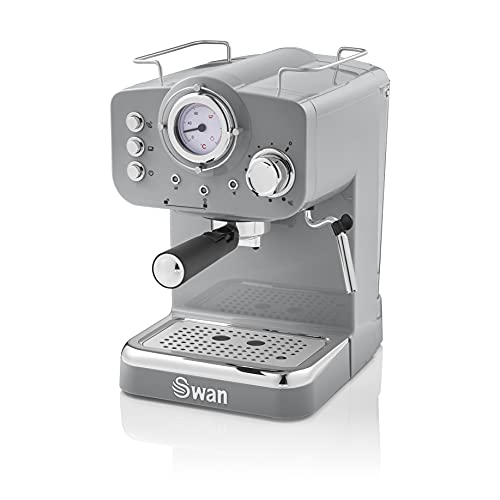How Does Machine Espresso Work?
The machine espresso is made using precision pressure, and a filter technology that is awe-inspiring to create the coffee you love. How exactly does it work?
Espresso is produced by pushing hot water under high pressure through finely-ground coffee. The process is similar to making drip coffee, but the difference is in the pressure.
The Head of the Group
The name implies, the group head is where you put your portafilter in when making espresso. It is responsible for dispersing water into the portafilter and controlling the pressure of the resulting extraction. There are several different types of group head, each with their distinct advantages and disadvantages. Some are focused on temperature stability, some on pre-infusion options, and others are designed to control the lever. Some have a combination, like the E61. This is a popular choice among baristas due to the fact that it has multiple benefits in a single package.
As you can see in the picture above, the group head is fitted with several notches. You can place your portafilter inside these notches, and then twist the head to secure it. There is also a gasket of rubber that is a part of the notches to help create a seal when you insert your portafilter into the machine. The notches permit precise placement of the portafilter. This is vital for an even extraction.
The group head is not just able to allow you to place your portafilter easily, but it also maintains the same temperature. It does this by circulating hot water through the brew basket, and around the portafilter, making sure that it's always at the correct temperature to extract. This is important because even a small difference in temperature can make the difference between excellent and great espresso.
The Pump
The motorized pumps in espresso machines that rotate provide the nine atmospheric bars of pressure required to extract espresso. This differs from manually operated piston machines that employ a lever. This pressure is built up by pumping water through a heat exchanger and then through the ground coffee.
Pumps are typically less expensive than piston-driven machines, and they tend to last longer, however both types of machine can be damaged by excessive use and inadequate cleaning. They also make mechanically complex, which can result in a high price tag on even the simplest models.
Certain espresso machines do away with the pump completely and instead employ steam pressure to create espresso. The drawback is that the same boiler that produces steam also increases the temperature of the water until it reaches boiling which can cause excessive extraction. These machines also have to constantly rebuild their pressure between cups. This takes energy and time.

Many espresso machines make use of either a rotary or vibration pump, which has a vibration model using a rotating disc to create pressure, and a rotary model pushing hot water through the grounds under high speed. Both models can produce an excellent espresso, however rotary machines are quieter and more durable than vibration pumps.
The Boiler
The boiler is what will heat the water to a temperature that is ideal for extraction. The steam that is created will eventually reach the portafilter, which is the container that holds the espresso coffee grounds. It is then pumped into the cup. During this process, the steam causes pressure to push through the grounds of the coffee. This results in a layer crema that is then poured over. This is a hallmark of a great espresso.
There are three kinds of espresso makers , which differ in the kind of pump they use and the degree of heat that the brew is. There are various ways to control the strength of the brew and the size of cup that can be made by the machine.
The first espresso machines were steam-type. They utilized one boiler to make both steam and brew, but the pressure they could create was minimal - two bars of atmospheric pressure maximum. This resulted in the coffee tasting burnt and bitter. This is the reason why Milanese manufacturers Luigi Bezzerra and Desiderio Pavoni created the modern espresso machine.
The most common espresso machine is a semiautomatic model with an electric pump. These are the things people think of when they think of an espresso maker. Semi-automatic machines require you to grind and tamp the beans yourself while the pump controls the flow of water and pressure. This is an excellent compromise between human touch and the mechanised consistency.
The Filter
Typically, espresso machines utilize filters to separate the coffee grounds as they pass through the hot water. The filter is also a vital component of the machine's temp control, as it prevents overheating.
It also enhances flavor, as it lets you enjoy a longer bloom phase. This allows the beans to let their nuances out, and improves extraction.
It is important to keep in mind that even the finest filter can result in a bad cup of coffee. The quality of the beans, and the extraction process, remain crucial.
It's here that the magic occurs. This is what makes espresso taste so good. The grouphead, also called the brew head, is the place where the portafilter (the thing you put the coffee grounds into) is placed when making espresso.
Steam-driven espresso machines use hot water that is heated inside an airtight container to produce steam. The steam then pushes hot water through the grounds of coffee at high pressure. These machines are less expensive and are easier for the user to maintain than pumps-driven models. However, they are limited in their ability to provide the perfect brewing conditions because they operate at 1-1.5 bars of pressure. The perfect shot requires 9-10 bars.
In recent times, espresso machines powered by a compressed air pump have become increasingly popular. They utilize an air compressor to force hot water into the grounds and are much more portable than steam-driven electric machines.
